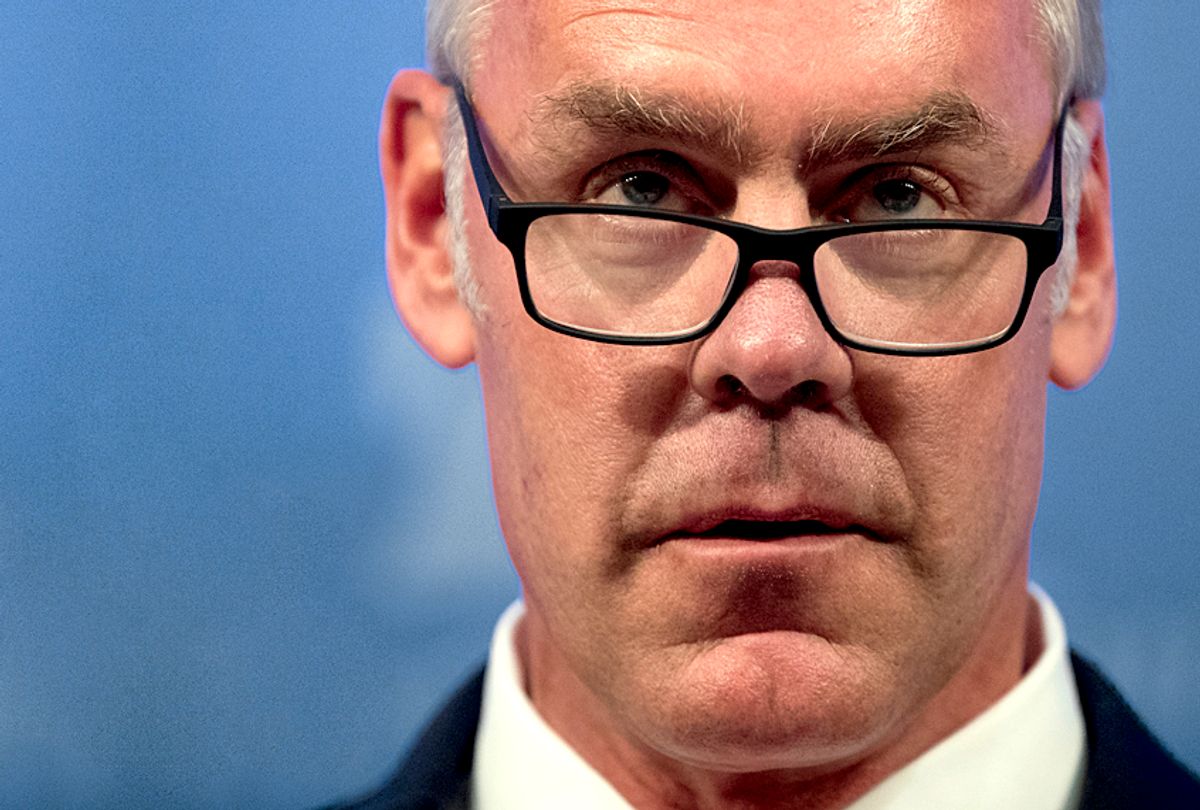Earlier this week, CNN reported that Interior Secretary Ryan Zinke has repeatedly offended people who work under him by dismissing the importance of diversity to the agency. Sources told CNN reporter Sara Ganim that Zinke had been saying things like "I don't care about diversity" and " We don't need to focus on that anymore," in response to questions about whether the Interior Department would continue to pursue diversity goals laid out by the Obama administration.
Zinke's spokeswoman, Heather Swift, got huffy when asked about these reports, telling CNN that "the anonymous claims made against the secretary are untrue" and noting that a few Zinke hires, herself included, are not white men. But to activists and former Obama officials that spoke to Salon, this rebuttal is insufficient.
“Actions speak louder than words," Clarence Fluker, who worked at Interior for the National Park Service and later on the Council on Environmental Quality under the Obama administration. “If diversity is important, and it’s not just lip service, what has your department done to really help make sure that diversity takes a top priority?”
Zinke's comments highlight a broader issue at the Interior Department and with the management of public lands generally: It's male-dominated and very, very white. More than 70 percent of Interior employees are white, and people of color tend to be shut out of equal access to public lands. A 2009 study found that 78 percent of national park visitors were white, while another study from 2014 found that less than one-fourth of national parks and monuments honored people of color, women or LGBT people.
When there is a lack of diversity "among perspectives and opinions about how we use our public lands" and among "the people who were at the table making those decision," said Kevin Bryan of the Next 100 Coalition, "then you’re not going to have a set of ideas that are responsive to the needs and concerns of the broad populations." Bryan's group is specifically focused on making public land benefits available to all.
“In particular, the National Park Service is often called America’s storyteller," said Kate Kelly, director of public lands at the Center for American Progress and an Obama-era Interior employee, "but if the only story they’re telling is one that is traditionally white and traditionally male, they’re missing huge chapters of America’s story."
During the Obama years, Fluker said, the administration put a priority on making sure that "all Americans would be seen and feel they were reflected" in decisions about public lands. "That diversity of thought, that diversity of past experiences, really helped to create a rich dialogue about how policy and outreach took place," he continued.
Obama designated a number of monuments meant to highlight the diversity of American history, including the Stonewall monument to gay rights in New York City, the Freedom Riders monument in Alabama, the Reconstruction monument in South Carolina and the Bears Ears monument in Utah, created at the request of a coalition of Native American tribes in the area.
The 2014-2018 strategic plan created by Obama's Interior secretary, Sally Jewell, emphasized the importance of a "highly skilled and engaged workforce that reflects the diversity of the Nation." But leaked documents show that Zinke's 2018-2022 plan abandons all language about diversity, focusing instead on plans to "generate revenues and grow the U.S. economy" by expanding oil and gas leases on public lands.
One of Zinke's biggest moves in his first year of office was recommending that President Trump reduce the size of Bears Ears by 85 percent, a plan that Trump embraced. In response, the five tribes who helped establish this monument, which covers many historical lands and precious artifacts, have sued to preserve the monument designation.
Zinke's public behavior has only reinforced suspicion that he has no interest in including people of color in his vision of the America that Interior is supposed to serve, protect and chronicles. In May, when a Navajo woman named Cassandra Begay confronted Zinke over his unwillingness to talk to tribal leaders about Bears Ears, he stuck his finger in her face and scolded her to "be nice." In October, Zinke dismissed requests to take down Confederate statues, saying that doing so was "a slippery slope" and adding that if "you’re a native Indian, I can tell you, you’re not very happy about the history of General Sherman or perhaps President Grant."
Most recently, Zinke responded to Rep. Colleen Hanabusa, D-Hawaii, expressing a desire that Interior pay respectful attention to sites recognizing World War II-era Japanese internment by exclaiming, "Konnichiwa!" Hanabusa responded by drily noting that the correct expression for morning is "ohayo gozaimasu." Hanabusa's fellow Hawaii Democrat, Sen. Mazie Hirono, characterized Zinke's response as "flippant & juvenile" in a Twitter post.
The Obama administration didn't just focus on increased diversity in staffing and representing people through national monuments. There was also an effort to make public lands more accessible to more Americans. There is, for instance, the Every Kid in a Park program started in 2015 that provides free park access to fourth graders and their families. Obama also designated the Valle de Oro wildlife refuge in Albuquerque, New Mexico, and the San Gabriel Mountains monument outside Los Angeles, both of which are far more accessible to urban dwellers than national parks and monuments typically are.
In contrast, Zinke has threatened to raise fees to $70 a car to visit some of the nation's most popular parks, which is likely to discourage even middle- and low-income families from visiting. This idea is even more risible amid reports that Zinke has spent lavishly on his own travel budget.
“I hear how President Trump talks about the billions of dollars that he wants for a border wall, something to help divide people," Fluker said, noting that "we have a national park system that everyone loves" that now has $11 billion in badly-needed deferred maintenance. "Take that money and help bring our country together, instead of trying to divide us," Fluker concluded.

Shares